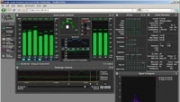Learning opportunities abound at AES

Ground loops, loudness measurements, digital delays, careers in broadcasting and lip-sync were among the topics covered in educational sessions at the 129th AES convention in San Francisco last week.
Digital delay
Delay in digital audio networks and processing used in live events was addressed, as well as how this delay affects the artists with stage monitoring. The affects of acoustical delays (1mS/Ft) and how it colors the sound you hear was also discussed.
Careers
Students of broadcasting were addressed in one session in which Steven Lampen, William Blum, Kim Sacks and myself talked about what it’s like working in the industry and what future broadcasters should know, other than IT, to make it in the evolving industry.
Ground loops
In this session, authors Bill Whitlock and Jamie Fox discussed the source of the currents that generate ground loops. Data was presented showing that many ground loops are induced into the safety ground within the facility wiring, even though it complies with local and national electrical codes. The authors found that twisting the hot and neutral wires together eliminates the possibility of one being closer to the ground wire than the other, thus eliminating magnetic fields that generate ground currents.
The professional video industry's #1 source for news, trends and product and tech information. Sign up below.
Loudness measurements
EBU R 128 is a new recommendation for measuring audio loudness, which is a hot topic as the new CALM legislation comes into play. Author Florian Cramerer stressed that program loudness must be addressed at the start of production all the way through to its broadcast. The basic concept of R 128 is to remove the peak audio levels from the loudness measurement so as to not bias the reading toward an overall higher level. As with any averaging system, peaks raise the overall level, even if they only account for a small percentage of the total. Leaving the peaks in the measurement process would cause that program to be much lower in overall volume.
On the exhibit floor, there were several manufacturers demonstrating their loudness measurement devices. One of note was Qualis Audio and its Sentinel surround audio program monitor. In talking with the founder of the company, Richard Cabot, he told me that not only does the Sentinel keep an eye on the 5.1 audio levels, it tracks the history of the loudness and stores a log of all audio measurements that can be viewed later. It can also downconvert 5.1 to stereo to monitor any potential problems.
Lip-sync
Lip sync remains a problem now and into the foreseeable future. One session at AES addressed this issue, with several presenters attacking it from various fronts. It was generally agreed that the problem would not be solved until new receivers that can compensate for and have larger buffers are manufactured and enter the market.
One of the presenters was Dan Desmet of Flanders Scientific. He presented data showing the varying amounts of delay present in some professional video monitors and how the delay changed depending on the format of the video sent to it.
The point was raised that in an editing booth, with the delay of the video monitor compensated for, the delay will change as the format of the video being edited changes. This can cause the editors to complain that the lip-sync was good in the morning but off in the afternoon as they switched to a different project with a different format.
